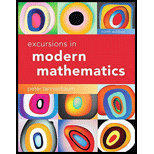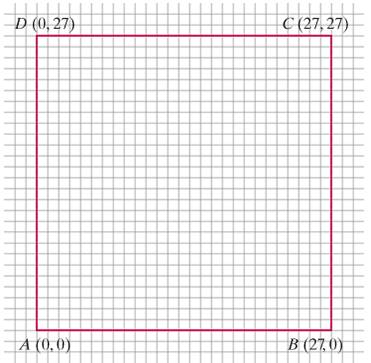
Concept explainers
Exercises 31 through 34 refer to a variation of the chaos game. In this game you start with a square ABCD with sides of length 27 as shown in Fig. 12-41 and a fair die that you will roll many times. When you roll a 1, choose vertex A; when you roll a 2, choose vertex B; when you roll a 3, choose vertex C; and when you roll a 4 choose vertex D. (When you roll a 5 or a 6, disregard the roll and roll again.) A sequence of rolls will generate a sequence of points P1, P2, P3 |elip| inside or on the boundary of the square according to the following rules.
• Start. Roll the die. Mark the chosen vertex and call it P1
• Step 1. Roll the die again. From P1 move two-thirds of the way toward the new chosen vertex. Mark this point and call it P2.
• Steps 2, 3, etc. Each time you roll the die, mark the point two-thirds of the way between the previous point and the chosen vertex.

Figure 12-41
Using graph paper, find the points P1, P2, P3 and P4 corresponding to
a. the sequence of rolls 2, 2, 4, 4.
b. the sequence of rolls 2, 3, 4, 1.
c. the sequence of rolls 1, 3, 4, 1.
Want to see the full answer?
Check out a sample textbook solution
Chapter 12 Solutions
Excursions in Modern Mathematics (9th Edition)
- Factor the polynomial completely. x^2- 9 A) (x - 1)(x -9) B) (x - 3)(x + 3) c) (x -3)(x-3) D) (x + 3)(x + 3)arrow_forwardPlease solve the following Probability problem. Show all work and solve all parts that are asked: HW 1.y.(Yutnori) Yutnori is played by 2 (groups of) players on a gameboard with pieces thatmove around. Each player takes turns throwing yut sticks - each stick hastwo sides, round and flat, which makes the stick roll. Five combinationsare possible with yut sticks: do, gae, geol, yut and mo. A player achievinga yut or mo is allowed to roll again. Combinations and the number ofmoves they allow on the gameboard are presented in Figure 3 (flat sideup is blank and round side up is filled with x-es). Assuming each of the 4 Yut sticks falls on both of its sides with equalprobability, what is the probability that:a) you roll a yut?b) you roll a geol ?c) you get a second roll?d) you move 6 spaces in your first turn?In reality, a typical Yut stick is designed so that the probability of flat sidefacing up is around 60%. Try to think of what the previous probabilitieswould be in this case.arrow_forwardRylee's car is stuck in the mud. Roman and Shanice come along in a truck to help pull her out. They attach one end of a tow strap to the front of the car and the other end to the truck's trailer hitch, and the truck starts to pull. Meanwhile, Roman and Shanice get behind the car and push. The truck generates a horizontal force of 377 lb on the car. Roman and Shanice are pushing at a slight upward angle and generate a force of 119 lb on the car. These forces can be represented by vectors, as shown in the figure below. The angle between these vectors is 20.2°. Find the resultant force (the vector sum), then give its magnitude and its direction angle from the positive x-axis. 119 lb 20.2° 377 lbarrow_forward
- 23 The line graph in the following figure shows Revenue ($ millions) one company's revenues over time. Explain why this graph is misleading and what you can do to fix the problem. 700 60- 50- 40 30 Line Graph of Revenue 20- 101 1950 1970 1975 1980 1985 Year 1990 2000arrow_forwardd of the 20 respectively. Interpret the shape, center and spread of the following box plot. 14 13 12 11 10 6 T 89 7 9 5. 治arrow_forwardF Make a box plot from the five-number summary: 100, 105, 120, 135, 140. harrow_forward
- An airplane flies due west at an airspeed of 428 mph. The wind blows in the direction of 41° south of west at 50 mph. What is the ground speed of the airplane? What is the bearing of the airplane?arrow_forward14 Is the standard deviation affected by skewed data? If so, how? foldarrow_forwardFrequency 15 Suppose that your friend believes his gambling partner plays with a loaded die (not fair). He shows you a graph of the outcomes of the games played with this die (see the following figure). Based on this graph, do you agree with this person? Why or why not? 65 Single Die Outcomes: Graph 1 60 55 50 45 40 1 2 3 4 Outcome 55 6arrow_forward
 Linear Algebra: A Modern IntroductionAlgebraISBN:9781285463247Author:David PoolePublisher:Cengage Learning
Linear Algebra: A Modern IntroductionAlgebraISBN:9781285463247Author:David PoolePublisher:Cengage Learning
